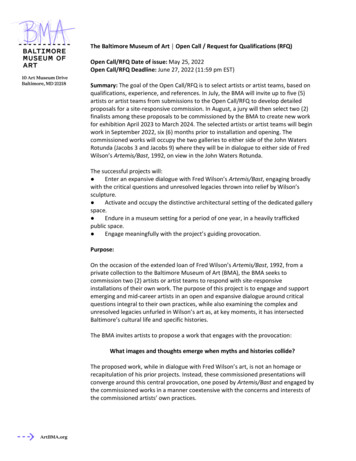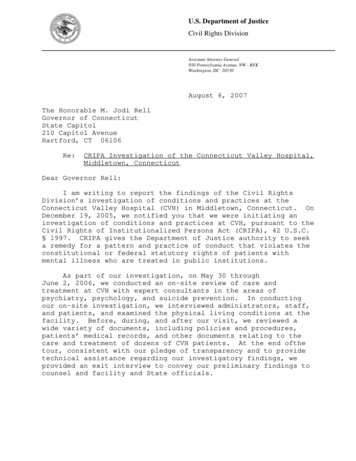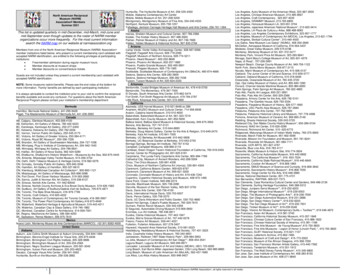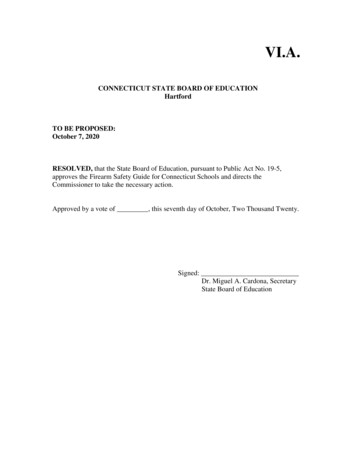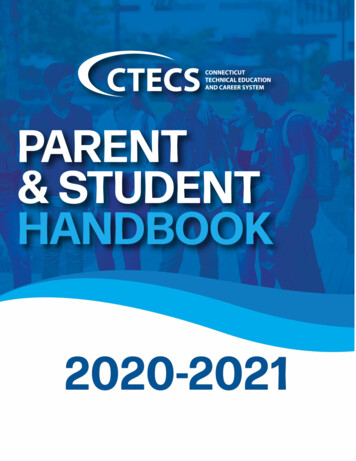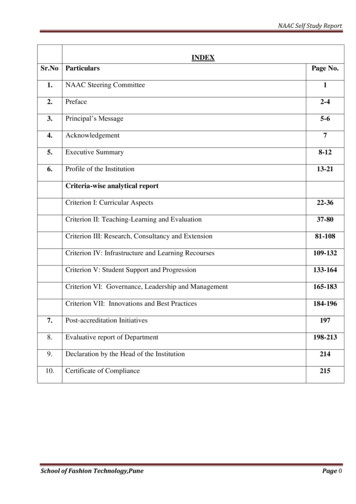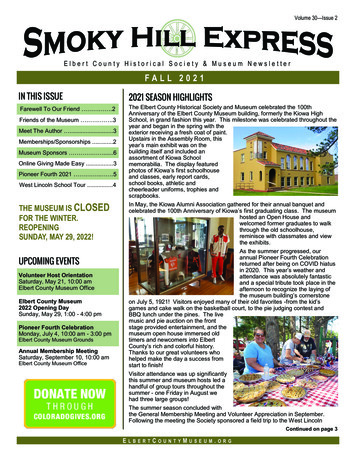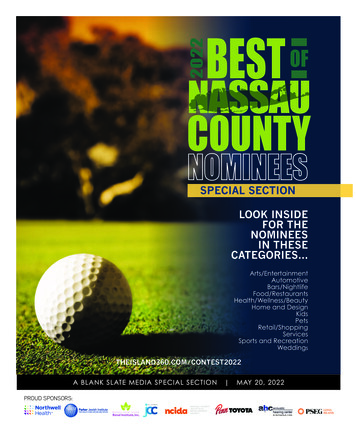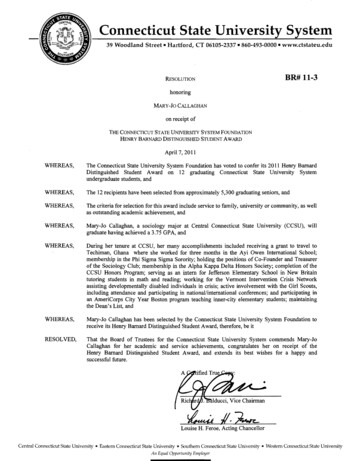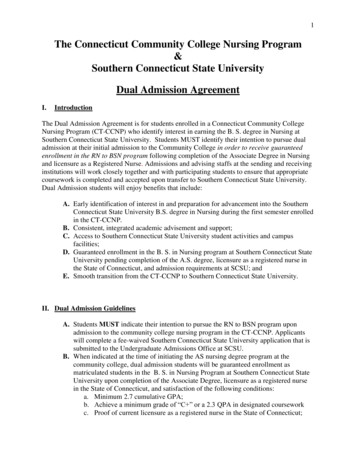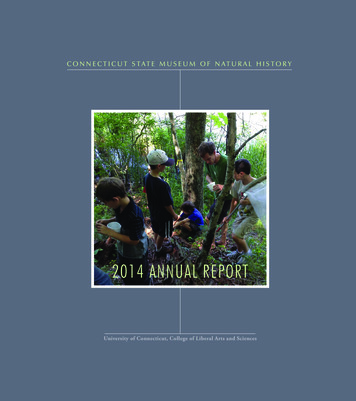
Transcription
C O N N E C T I C U T S TAT E M U S E U M O F N AT U R A L H I S TO R Y2014 ANNUAL REPORTUniversity of Connecticut, College of Liberal Arts and Sciences
O UR MIS S IO NBOARD OF DIRECTORSWilliam Morlock, ChairmanLiz Buttner, CT Department of EducationJean Crespi, Geosciences and Biology, UConnThe Connecticut State Museum of Natural Historyand Connecticut Archaeology Center serve theUniversity of Connecticut and the public bypromoting an understanding and appreciation ofour natural and cultural world, especially as relatedto New England.Steve Fish, CT Department of Environmental ProtectionCarl Lindquist, M.D.Natalie Munro, Anthropology, UConnMorty Ortega, Natural Resources, UConnKarin Peterson, CT Commission on Culture & TourismDavid Wagner, Biology, UConnWalter Woodward, State Historian, UConnSTAFFNick Bellantoni, State ArchaeologistDavid Colberg, Program & Public Information CoordinatorMegan Delaney, Membership CoordinatorCollin Harty, Exhibit & Communication DesignLeanne Kennedy Harty, DirectorRobert Thorson, Affiliated Faculty, Stone Wall InitiativeTemporary Staff Assistance for the OSA provided by: Heather Alexson.STUDENT STAFFZachary ClarkChristine GagnonAngelina HernandezMyles JonesCarey MacDonaldJames McGannKelsey SullivanWithin the mission, the Museum’s fundamentalgoals are to acquire and preserve collections and touse collections, exhibits, and programs: To cultivate an interest about naturalhistory among the citizens of Connecticut. To communicate the significance andvulnerability of archaeological andnatural resources. To enhance University learning, teaching,and research. To enrich elementary and secondaryeducation. To acquire and present knowledgeabout the natural and cultural history ofConnecticut and New England. To showcase the academic resources ofthe University of Connecticut and providea public connection to them.
IN OUR FALL 2013 NEWSLETTER, WE MADETHE FIRST PUBLIC ANNOUNCEMENT OF THERETIREMENT OF STATE ARCHAEOLOGISTNICK BELLANTONI. PREPARATIONS FOR THATEVENT FRAMED 2013-14 FOR THE MUSEUMD E A R FRIEND SLooking back, twenty-building and brought BioBlitz to CT, to Leanne HartyIN MANY IMPORTANT WAYS—AND AS THEYEAR CAME TO A CLOSE, WE ASKED NICK TOSHARE SOME THOUGHTS AND REFLECTIONS.seven years has sped by,who instituted the Connecticut Archaeology Centerbut the last few monthsas part of the Museum and guided its growth throughhave allowed time to re-very difficult economic times.flect on the accomplish-Continuity and growth are the results of thements and growth of the Office of State Archaeologystaff’s teamwork and vision. However, no matterand the State Museum of Natural History over thathow dedicated and hard working the staff is,span. When we started, there was one piece of statecontinuity and growth we always dependent on onelegislation referring to OSA, andvariable: the steadfast supporttoday, the office is written intoof Museum members, donorstwelve sections of the state’sand friends. Any success thestatutes with expanded rolesMuseum and OSA have had, andand responsibilities; our anthro-will have, is directly correlatedpological collections grew fromto your continued support.thousands of artifacts to hun-As we prepare to turn thedreds of thousands; our serviceeveryday operations of OSAto the state expanded by assist-over to Dr. Brian Jones, knowing in crime scene investigations with law enforce-that I will stay connected with the Museum byment officials at the municipal and state levels; andassuming new roles, such as serving on theOSA has developed productive working relationshipscommittees, providing institutional memorywith the Native American and history communities.to the board of directors and working with theWe witnessed transformation over our tenureUConn Foundation to advance opportunities towith changing Museum directors and staff, from ourfurther the Museum’s mission.founder, Carl Rettenmeyer, who established the StateThe Lakota Indians have no word in theirMuseum in the Wilbur Cross building and broughtlanguage for “good-bye”. They simply say, “untilhundreds of people to campus with Family Days,the next time”, so following suit, I’ll say, “until theto Ellen Censky who moved us to our new museumnext time we see you at a Museum program.”1Nicholas Bellantoni, PhDConnecticut State Archaeologist
O VE RVIE WThe Connecticut State Museum of Natural History at UConn supports the University’s mostfundamental academic traditions—traditions built not only on passing knowledge to future generations,but also on applying this knowledge to solve problems and improve the quality of people’s lives.The Museum provides a unique platform to showcase the teaching, research, and resources of theUniversity of Connecticut by providing opportunities for people of all ages to interact with and learn fromleading scholars in meaningful and engaging ways. As University Public Engagement efforts becomean increasing focus with the introduction of UConn’s new Academic Plan and the designation of 2014as the UConn Year of Engagement, the importance of the Museum in the University’s public educationand community outreach endeavors is underscored. Through the Museum’s permanent exhibit,Human’s Nature: Looking Closer at the Relationships Between People and the Environment, campusand community-based programs, collection displays, traveling exhibits, and outreach activities, theMuseum served approximately 90,000 people this year.E D UCA T IO NPROGRAMS To advance ourmission and goalsIn field learning activities, participants haveto increase people’s understanding of natural andthe opportunity to conduct experiments, test ideas,cultural history, and the intimate role of humans inmake field observations, and use tools they mightit, the Museum offered fourteen field learning ac-not otherwise have access to. Activities this yeartivities, two workshops, one KASET science mod-included tours of historic cemeteries with Ruthule, one adult field school, two day trips, and eightShapleigh-Brown of the Connecticut GravestoneMuseum lectures this year. The Museum also co-Network, hands-on experiences in marine sciencesponsored seven Teale lectures and participatedwith Project O, and a unique behind-the-scenesin six community events. Below are some of thetour of the Connecticut Historical Society. Seniorprogram highlights from those 42 activities.Extension Educator Donna Ellis taught IPM ba-2
sics in Managing Pesky Plants and Other Pests,Illustrator with the biological sciences at UConn,and educator Paula Coughlin presented two fieldpresented Scientific Illustration— Flora of the Fallactivities: Animal Tracking and The Birds of Baffinand Winter! utilizing museum specimens in teach-Sanctuary. Ed Richardson and Frank Kaputa froming illustration techniques. Mandy Ranslow led thethe Notable Trees Project and Arborist John KehoeArchaeology Field Workshop – Learning The Ba-from UConn’s Landscape Department led a tour ofsics. Participants learned what happens at an ar-UConn’s largest and unusual “Champion” trees.chaeological dig, including the science, field tech-Astronomy programs continued to be popularniques, tools, and cultural aspects of archaeology.and Dr. Cynthia Peterson fromParticipants spent an ex-UConn’s Physics Departmentciting week in Museum’s fieldled Look Up! Viewing Spring’sschool programs each sum-Night Sky. We also retuned tomer. The Museum’s Archae-Cedar Hill Cemetery to learnology Field School for adultsabout Connecticut soldiers andwas led by Dr. Bellantonicitizens whose lives and ser-and returned to an 18th-19thvice records tell the story of thecenturyAmerican Civil War. In our newin Ashford, Connecticut. Thehistoricfarmsteadseries, Exploring Connecticut’s Towns, the firstMuseum and Archaeology Center also continuedtown explored was Manchester, with a tour led byits participation in the longstanding UConn KidsSusan Barlow from Manchester Historical Society.Are Scientists and Engineers Too (KASET) pro-The second town explored was Durham, CT guidedgram with the popular Archaeology Field Schoolby Sarah Atwell from the Durham Historical Soci-for Kids module.ety. In addition, we offered a new special event forMuseum Day Trips included the Metropolitan Mu-museums members–a tour aboard the Connecticutseum of Art in NYC, and a day trip to Boston gave par-River Museum’s historic schooner Mary E.ticipants the opportunity to explore the New EnglandMuseum workshops offer smaller group op-Aquarium, and for those interested, a chance to visitportunities to participants. Virge Kask, Scientificthe nearby historic Faneuil Hall Marketplace.3
Experts from diverse academic backgroundsDr. Kevin McBride from the Mashantucket Pequotshared their knowledge and research in numerousMuseum and UConn Anthropology Departmentlectures presented by the Museum. Highlightingdiscussed the national significance of the Pequotthis year’s offerings were: Spectacular SilkwormsWar. Dr. John Cooley from UConn’s Departmentby Ann Galonska, Director of the Mansfield His-of Ecology and Evolutionary Biology talked abouttorical Society. Elizabeth Collins, Archives Re-the past seasons of periodical cicada research andsearcher with the Hill-Stead Museum, presented Aupdates on the Magicicada Mapping Project. TheDiscovery of “Mammut” Proportions, celebratingMuseum continues to co-sponsor the Edwin Waythe 100th anniversary discov-Teale Lecture Series, whichery of an American Mastodonbrings leading scholars andskeleton in Connecticut. Dr.scientists to the University ofDebarchana Ghosh from UCo-Connecticut to present publicnn’s Department of Geographylectures on nature and the en-and Heather Smith Pease fromvironment six times each year.UConn’s Cooperative Extension,COMMUNITY OUTREACHEVENTS The Museum partici-shared how the quality of foodchoices in neighborhoods affects diet and health behaviors in Do You Live In Apated in a number of popular large-scale communityFood Desert? How Many Calories Can 1 Get You?events in 2014. These events included the 10th FestivalDr. Lucianne Lavin, Institute for American Indianon Green in Mansfield, the Hammonassett Jamboree,Studies Director Research and Collections pre-the Connecticut Archaeology Fair, the Annual Big Ysented Connecticut’s Indigenous Peoples, sharingKids Fair, the Connecticut Flower & Garden Show, andnew archaeological and ethnographic discoveries.Elizabeth Park’s Rose Sunday in Hartford. Participa-UConn Master Gardener Gary Schulte explored thetion in these well-attended annual events helps createevolution of plant materials utilized in medicineawareness of the Museum and Archaeology Centerin his talk Medicinal Plants - Rich History, but isand advance our mission, with special emphasis onthere a Future? Battlefields of the Pequot War byunique educational opportunities for the general public.4
On campus, participation in statewide events wasCo-chair Karen Filchak (Extension Educator in thehighlighted once again by the Invention Conven-College of Agriculture and Natural Resources), Mu-tion. As a supporter in the program, the Museumseum Director Leanne Harty provided organizationalprovided notepads to partici-coordination of programming2014 ATTENDANCEand projects which continuedPublic ProgrammingWorkshops & Trips .350Lectures .1,475Meetings & Events .650Total .2,475Outreach ActivitiesSmall Group.1,500Community Events .61,240Total .62,740ognizing the University’s strongand produced two new small-mission, and a prominent fo-ExhibitsIn-House Exhibits .2,800Collections on Display.25,000Total .27,800cus area in the new AcademicTotal Attendance.93,015in January, and featured thepants and teachers, along withcoupons for discounts and over500 programs for distributionto attendees. The Museum wasopen to the public throughoutthe day of the event, and welcomed participants and visitorsto explore our exhibit.UCONN YEAR OFENGAGEMENT PublicEn-gagement is a central tenet ofthe University of Connecticut’sPlan. To celebrate and advancethis important work, 2014 was* Approximate--Does not include the Mashantucket Pequot Museum & Research Center.designated as the “Year of En-through the end of 2014, rectradition of community outreachwhile advancing goals and initiatives in the new Office of Public Engagement.EXHIBITSThis year the Mu-seum developed, designed,scale exhibits. The first, Thinking Like an Archaeologist, is an11-panel display that openedphotos of John Spaulding, along-time volunteer for the Office of State. John photo-doc-gagement” (YOE) at UConn. University-wide effortsumented nearly all excavations of the OSA over ato showcase service-learning and engagement10-year period. He assembled a remarkable bodyprograms, celebrate best practices, and promoteof work, consisting of thousands of images thatengaged research and scholarship have been on-truly captured the diversity and practice of moderngoing throughout 2014. With Year of Engagementarchaeology in Connecticut. This exhibit focused5
on his photos from three sites that were particu-the display was provided by the Museum and sup-larly effective at communicating the thought pro-ported by the Dorothy Goodwin Fund.cess, historic research, field and lab techniques,During 2014, the Rex Brasher exhibit was dis-and human stories behind each excavation.played in the offices of the Commissioner of theThe second, Snow, Sand & Strategy: How DidDepartment of Energy and Environmental protectionWeather & Geography impact World War II? isin Hartford. This extended arrangement gave newa 9-panel display that opened in May. It was theaudiences an opportunity to view the framed printsresult of collaboration between the Museum andand was an excellent opportunity to begin the trav-UConn’s Neag School of Educa-elling life of the 14-piece framedtion. The content in for the dis-set. This year, with coordinationplay was researched and writtenby the Dodd Center, Rex Brasherby fifth year students in the his-was one of several Connecticuttory teacher education programartists featured in Haven and In-under the guidance of Associatespiration: The Kent Art Colony,Professor Alan Marcus as a parta special exhibit that opened inof his Teaching History with FilmJune 2014 at the Mattatuck Mu-and Museums. The purpose ofseum in Waterbury, CT.the project was to help students experience first-Thishand what goes into developing a museum exhibitmaintenanceso that these future history teachers would be betterpermanent exhibit, Human’s Nature: Lookingable to use and collaborate with museums. Work-Closer at the Relationships between People anding with CSMNH staff, they worked to think criti-the Environment, when two of the five digitalcally about communication in a museum setting,video players required repair. The total expensedevelop an exhibit script, and select and organizewas less than 1000—reasonable, consideringvisual media to most effectively communicate theirthe units each had over 10,000 hours of playingmessage. Final graphic design and production oftime since theMuseum’s
R E S E A R C H & A CA D EMICSTHE OFFICE OF STATE ARCHAEOLOGYon the River Protection Advisory CommitteeState legislation has established numerous ar- Archaeologicaleas of responsibility for the Office of Archaeol-threatened with destructionogy (OSA). Each year, the work associated with Public and private research of “the high-each of these duties brings the State Archae-est possible standards in archaeologicalologist to nearly every Connecticut municipal-investigations”ity, and yields new information and insights Publication and dissemination of informa-about our state’s material culture and culturaltion about the ethnohistory of the region,salvageofpropertiesheritage. These responsibili-and responding to inquiriesties include:about the state’s archaeologi- Oversight of in situ pres-cal resourceservation,archaeological Maintaining comprehensiveexcavation, or reburial ofsite files and maps (moreNative American humanthan 5,000 records)remains uncovered by any Membership on the Historicground disturbancePreservation Council, which Curatorial oversight ofadvisestheConnecticutCommission on Culture and Tourismover 600,000 artifacts reposited at the Connecticut State Museum of Natural History Oversight of an inventory of Native Ameri-Charged with reviewing all proposals forcan cemeteries, and preservation of otherconstruction and modification of land wherehuman remains and cemeteriesarchaeological sites may be located in Con- Acting on recommendations made by thenecticut, the State Archaeologist conductedNative American Heritage Advisory Councilover 50 field reviews and site meetings in Providing recommendations on proposedcommunities this year. In addition, the OSAState Archaeological Preserves, and servingevaluated numerous project proposals for7
state municipalities during that period usinga bullet from the battlefield at Gettysburg.site files and other reference materials. Ap-The other capsule contained coins, letters,proximately 20,000 miles were logged in OSAroster lists, and a medal from the Grand Armytravel once again this year.of the Republic.The State Archaeologist’s activities oftenThe story of Albert Afraid of Hawk, aspark great interest among the general publicLakota Sioux who died in June 1900 whileas well as those in the professional anthro-performing with Buffalo Bill’s Wild West Showpology community. Particularin Danbury, CT, generatedhighlights during 2013-2014increasingincluded the ongoing story ofyear. Dr. Bellantoni’s travelthe New Haven Green’s Lin-to the Pine Ridge Indiancoln Oak. When winds fromReservation in South DakotaHurricane Sandy toppled Newwas one highlight of theHaven Green’s “Lincoln Tree,”activities, where he reunitedplanted in 1909 to mark thewith the Afraid of Hawk100th anniversary of Presi-family members and gave adent Abraham Lincoln’s birth, the toppled treeinterestthispresentation at Oglala Lakota College.uncovered human skeletal remains from theAsalways,theConnecticutStatelate 1700s and two time capsules. Dr. Bel-Archaeologist received numerous requestslantoni worked with Dr. Gary Aronsen, an an-this year to provide special lectures aboutthropologist in the Yale Department of Anthro-his experiences and investigations. Duringpology, as well as city and church officials inthe 2013-2014 year, 20 lecture requests werethe identification of human remains and theirfulfilled with over 1,250 attending. Hundredsproper reburial. The contents of one time cap-of people were also served through informalsule revealed Lincoln memorabilia, includingvisits and talks throughout Connecticut by themedallions, newspapers, a grapeshot ball, andState Archaeologist this year.8
C O L L E CT IO NS & L O A NSIn an effort to keep up with the ever-expandingSpecimens from our educational natural historyarchaeology collections, work was undertakencollection in Building #1 were used for the thirdthis year to reorganize Building 1 on Horsebarnyear by the Benton Museum for the annual DrawHill Road to identify more storage space. WeOn! event. Draw On! is a four-day program, wherewere able to expand our collections shelvingmaterials, ideas, and encouragement is offered tosystem by 20%. Much of theartists of all ages and abilities.month of May was given overThe Museum provided mountedto planning for, purchasing andmammals, birds, insects, andassembling the shelves, thenskeletal material. Charles Swarttransporting various collec-PhD, Senior Lecturer at Trinitytions from around campus toCollege, also took on loan severaltheir new home. These collec-of our owl and bat mounts as antions are now more secure andeducational aid for a class he wasbetter organized for future use.teaching involving echo location.A D M INIS T RA T IO NPRINT COMMUNICATION The Fall Newslet-overarching theme for the newsletter thatter in 2013 was the Museum’s first publicexamined the history and responsibilities ofannouncement of the upcoming retirementthe Office of State Archaeology. Both arti-of State Archaeologist, Dr. Nicholas Bel-cles were reproduced as PDFs for electroniclantoni. In anticipation of the search for adistribution to audiences that our printednew State Archaeologist, we developed annewsletter might not reach.9
ELECTRONIC COMMUNICATION The MuseumPUBLIC INFORMATION Diverse media cover-continues to manage three websites. Our mainage is an important component of the Muse-CSMNH/CAC site, http://www.cac.uconn.edu/ orum’s public information and marketing strategy.http://www.mnh.uconn.edu/ had 24,985 visitorsNumerous online calendars are utilized, sharingin 2013-14, and a total of 721,297 hits through-Museum programming with the public throughout the site. Our BioBlitz site, http://web.uconn.a wide variety of news media, educational, cul-edu/mnh/bioblitz/ received 1,287 visits, and ourtural, and tourism outlets. Press releases areIssues in Underwater Archaeology site, http://regularly distributed to Connecticut’s mediaweb.uconn.edu/mnh/underwa-outlets, sharing unique storiester/ received 1,109 visits.on the Museum endeavors aswell as promoting upcomingOur 2013 Annual Report wasMuseum activities.designed exclusively for onlinedistribution through our web site.Friends and supportersThis effort decreased printing andworldwide follow the Museummail expenses while continuing toon Facebook. This year weproduce documents at the profes-had more than 900 follow-sional level of our traditional print-ers and have seen consistented matter. Past newsletters are also archived online forgrowth in that number each year. Additionalviewing several months after original distribution.communications provide information and reg-The importance of cross-platform marketing,ular programming updates to approximatelyand the flexibility of tailoring our growing email1,200 members, friends, and communitymailing lists to specific audiences contributes togroups. The Museum also utilizes the Univer-cost savings, and electronic distribution has be-sity’s Daily Digest announcements to sharecome standard for invitations to events such as theinformation with the UConn community, reach-new temporary exhibits, special member events,ing 15,000 people regularly including faculty,and the release of our annual holiday card.staff, and students.10
MEMBERSHIPOverall membership numberscluded Kelsey Sullivan, Myles Jones, Angelinaremained steady this year, with a standard mem-Hernandez, Christine Gagnon, James McGann,bership average renewal rate of 73% and an OwlMatt Tuscano, Moriah Whitehead, and Kathleen(donor) membership average renewal rate of 88%.Lynch. From greeting museum visitors, organiz-Through the Membership Office, the Museum anding artifacts and site files, registering people forArchaeology Center provided complimentary one-programs, and supporting educational activities,year Family Memberships to schools and charitiesstudent staffers bring enthusiasm and a diverseto be auctioned as prizes during fundraisers.set of skills to the Museum. This year we also con-In June, the Museum’s half-tinued participation in UConn’stime Membership CoordinatorWriting Internship Program. Ka-Megan Delany resigned to ac-tie Loughrey served as a writingcept a full time position in theintern with the Museum and Ar-College of Agriculture, Healthchaeology Center this year.and Natural Resources. Due toEight students in the depart-budget difficulties in CLAS, wement of Ecology and Evolution-learned that the position unfor-ary Biology received studenttunately would not be re-filledawards and research supportin the coming year. The Museum is working tofunding from the Museum this year. In addition toidentify new ways to manage priority tasks, suchthe Undergraduate Teaching Assistantship award,as donations processing, for the foreseeable future.funding for student support was made possibleSTUDENTSfrom a number of named endowments includingThe Museum had 12 UConn un-the Clark, Wetzel, Rankin, Manter, Slater, and De-dergraduate students working in the departmentCoursey funds. The principal in these funds con-this year. New students were Zachary Clark,tinues to grow and insure that support for studentCarey MacDonald, Emmanuel Oppong-Yeboah,research and awards in the department will con-and Zachary Raslan. The returning students in-tinue in perpetuity.11
VOL U N T E E R SD O NO RSCONTRIBUTING EXPERTSSarah AtwellJack Barclay*Susan BarlowLauran BermanConnie BorodenkoAshley A. BissonnetteElizabeth CollinsJohn Cooley*Paula CoughlinHeather Cruz*Donna EllisMary FalveyAnn Galonska*Debarchana Ghosh*Bruce GreeneRebecca GrossMarcie JacksonFrank KaputaVirge Kask*John Kehoe*Laurie Pasteryak LamarreLucianne Lavin 100,000 AND UPBeverly LucasKathleen Lynch*Alan Marcus*Kevin McBride* (students)Mary MullerGary NolfKenneth Noll*David NaumecCynthia Peterson*Dawn Pettinelli*Project Oceanology StaffMandy RanslowEd RichardsonPaul ScannellGary SchulteRuth Shapleigh-BrownStephen SillimanHeather Smith Pease*Deborah SuabianDavid Wagner*Walter Woodward*Dr. John L. C. Lof 1,000 - 4,999Dr. Robert S. and Mrs. Marilyn C. CurtisFriends of the Office of State ArchaeologyDr. Kent E. Holsinger and Mr. Bill D. Cannon 500 - 999Dr. Linda E. and Mr. Richard E. BireleyDr. George A. Clark Jr. 250 - 499Mrs. Shirley W. BertramEversource Energy Foundation, Inc.Lillian G. Harter PhDMrs. Gerry P. and Mr. James D. HarveyMs. Ann H. HunyadiMrs. Rebecca T. and Dr. Scott K. LehmannDr. Carl W. and Mrs. Julia J. LindquistCarl W. Schaefer PhDDr. Laurence E. and Dr. Judith E. SkogDr. David L. WagnerMr. Keith E. Wilson and Ms. Marjorie A. HayesDOCENTS & PROGRAM VOLUNTEERS 100 - 249Heather AlexsonBonnie BeatriceKen BeatriceScott BradyMike CahillMarlo Del ChiaroBruce GreeneAngelina Hernandez*Dick HughesJames McGann*Gary NolfC. Thomas PaulJeremy PilverMandy Ranslow*Aetna Foundation, Inc.Dr. Mona J. and Dr. Gregory J. AndersonMrs. Ruth A. and Mr. Alphonse AvitabileMr. Harry H. and Mrs. Honey BirkenruthDr. William R. and Mrs. Jean F. BronsonDr. Allan C. Carmichael and Dr. Terry SteinMr. William R. CathcartDr. Dorothy O. and Dr. Peter K. CheoMrs. Linda and Mr. Denis CunninghamMs. Mary R. DeveauMrs. Mary V. and Mr. Kenneth R. FeathersMrs. Dorothea B. and Mr. Elmer M. FischerMr. Steven O. and Mrs. Linda H. FishMr. John C. FolsomMrs. Sandra L. and Mr. David W. GoodrichMrs. Gretchen O. Hall and Mr. Roswell G. Hall IIIDr. G. M. and Mrs. Jane D. HowardMr. Paul J. Kaminski and Mrs. Carol Donovan*UConn faculty, staff, students, or alumniPat ReardonCynthia RedmanFrederick RivardGlenda RoseElliot SchwamWill SikorskiKelsey Sullivan*Roger ThompsonJim TrocchiCarol WestLee WestMoriah Whitehead*
Mrs. Mary J. F. Kelsey and Mr. Roger A. Kelsey Jr.Dr. Quentin and Mrs. Margaret M. KesselDr. James R. Knox Jr. and Ms. Jane L. KnoxMrs. Kim P. and Mr. John C. KowszFiona J. Leek PhDMrs. Stacy T. and Mr. Robert E. MaleckiDr. Louis and Mrs. Laurie MameliDr. David MarkowitzMrs. Doris T. Martinchek and Mr. Robert J. Martinchek Sr.Dr. Antonio H. and Mrs. Marjorie J. RomanoMr. James R. and Mrs. Deborah S. RusselMr. George B. and Mrs. Lucile C. TowleMr. Sjef A. van den BergMr. Rudy F. and Mrs. Gail L. VoitMs. Sylvia H. WagnerMr. Lee F. and Mrs. Carol E. WestMr. Russell H. Wheeler Jr. and Mrs. Stephanie A. WheelerMr. Raymond J. and Mrs. Sarah W. WinterMs. Ruth L. WoodfordMrs. Gloria P. Wraight and Mr. John E. Wraight Jr. 100 AND UNDERMrs. Judith R. and Mr. Peter S. AndersenMr. Robert D. and Mrs. Jane W. AtkinsonDr. Elizabeth R. and Dr. Gerhard AustinMs. Rita M. BarredoMrs. Janice and Mr. John A. BendaMr. Curtis M. and Mrs. Carol A. BernerMr. Gary W. and Mrs. Donna BigelowDr. Carole T. and Mr. Charles A. BosterMr. Scott M. BradyDr. John P. H. and Mrs. Elaine K. BrandMrs. Doreen K. BrewsterMs. Maryanne Brustolon and Mr. Larry OswaldMr. Michael J. and Mrs. Anita J. CarranoMs. Ellen CastaldiniMs. Helen J. CollinsMs. Devon A. Conover and Mr. Everett L. PaluskaMs. Elaine Corey-Zincavage and Mr. Walter Zincavage Jr.Professor Nancy E. and Mr. Kevin CroninMr. Charles C. and Mrs. Catherine B. CrowdisMs. Faith D. DavisonMs. Amy M. DeBaunMs. Deborah J. DelaneyProfessor Emeritus Clifford E. Desch Jr. and Mrs. Cathy E. DeschDr. George M. and Mrs. Jane DonahueMr. Rudy J. and Mrs. Joy P. FavrettiMs. Nancy J. FerlowMr. Edward and Mrs. Elizabeth FournierMr. Stephen R. GephardMr. Glen B. and Mrs. Ann K. GlaterMrs. Bette D. GlickmanDr. Harland and Mrs. Ruth A. GraimeMs. Jeanne R. HaasMs. Nusie M. Halpine and Mr. Jeffrey M. LevineMs. Carolyn B. HebertMr. Hamilton and Mrs. Katherine K. HoltMr. Frederic W. and Mrs. Jean K. HopkinsMrs. Marjorie L. HoskinMs. Janet C. HuberMs. Anne H. IsbisterMs. Kathryn L. James-Stebbins and Mr. James S. StebbinsMr. Eric C. and Mrs. Elizabeth C. JonesMr. Christian and Mrs. Julia JosephMs. Susan KaehrleMr. Charles J. and Mrs. Joan E. KatanMrs. Phyllis L. and Mr. Steven KatzMrs. Judith A. and Mr. David J. KennedyDr. Youssef and Mrs. Ann KouatlyMr. H. Russell KunzMrs. Jean L. and Mr. Lanny M. LaughmanMrs. Theresa J. and Mr. Doue R. LaVoieMrs. Anita Z. and Dr. Gerald M. LeibowitzMrs. Diane LindsayMr. John D. Little Jr. and Mrs. Ava L. LittleMrs. Tannis E. and Mr. Richard E. LongmoreMr. Richard P. Maidment and Ms. Sandra L. TosiMrs. Nancy W. and Mr. Thomas MannMs. Ann M. MattioliMrs. Margaret B. McCarrickMrs. Ida G. and Mr. Nelson B. MeredithMr. William H. Moorhead IIIMs. Ruth B. MorrillDr. Letitia R. and Mr. Mark L. NaiglesMr. John D. and Mrs. Jan M. NeumuthDr. Richard L. Norgaard and Ms. Karen ZimmerMr. Thomas M. and Mrs. Carol A. O’DellJane E. O’Donnell PhDMrs. Nancy A. and Mr. John J. PacynaMr. Michael A. PellandMs. Patricia A. Peters and Mr. Andrew M. Szych Sr.Dr. Cynthia W. and Dr. Gerald A. PetersonMrs. Carolyn J. and Mr. Dale W. PettyPfizer FoundationMr. Frederick J. and Mrs. Barbara J. PogmoreM
from UConn's Landscape Department led a tour of UConn's largest and unusual "Champion" trees. Astronomy programs continued to be popular and Dr. Cynthia Peterson from UConn's Physics Department led Look Up! Viewing Spring's Night Sky. We also retuned to Cedar Hill Cemetery to learn about Connecticut soldiers and
